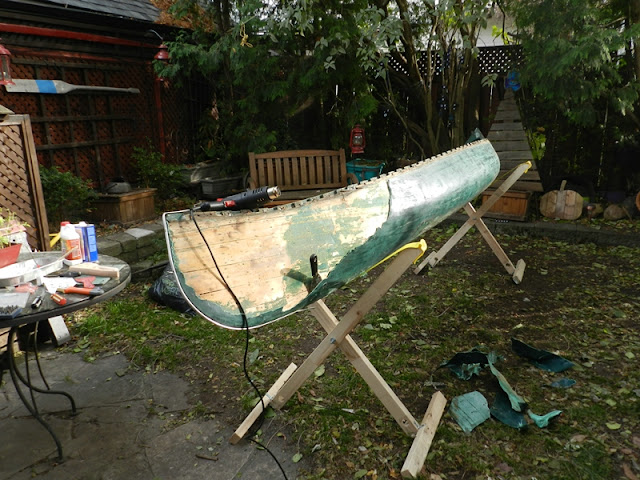Closer inspection of the 14' Trapper's Canoe revealed a bunch of home-made additions and repairs.
This model of Peterborough Canoe (Mermaid) originally came with a wide shoe keel. When the canoe was fiberglasssed in the 1960s, the shoe keel was removed and the holes in the ribs plugged with dowels and covered with a little bit of resin. You can see them in the 1st, 3rd, and 5th ribs below:
After glassing the hull, three narrow oak were mounted to the hull, each with their own fastening system in an amateurish way.
One keel seemed to have re-used the old flat-head bolts and nuts from the show keel and some were mounted with steel washers. The centre keel used a variety of Robertson screws to attach from inside the hull through the ribs & planking. Rather than re-use the existing holes from the shoe keel, the owner opted to mount with new holes on alternating ribs. The final keel was attached the other way with the screw head drilled in from the keel side and the tips piercing the interior of the hull. The intention was likely to hide the tips by embedding them into the ribs, but the original owner missed and ended up leaving sharp, exposed screw tip in the planking. You can just see the rusted tip of one such screw where the awl blade is pointing below:

Each of these stainless fasteners was heavily corroded and/or covered in paint so removing each was a battle without stripping the head. In the end, I ended up patiently heating each up for about 5 minutes with an an electric soldering pen to break up the cohesion and it really did the trick. A heat gun was then used to soften up the resin and cloth applied to the keels. It took a while but slowly and surely the fibreglass layers were removed and the wood keels exposed. All three oak keels were heavily rotted under their glass layer and basically crumbled when pried off the hull. Definitely see why glassing a hull can accelerate wood rot with canvas canoes.
All this took a very long day of dealing with corroded fasteners and such. Ended up weighing all the discarded glass covering the triple keels as well as the oak remnants and rusted screws/bolts. This little canoe surgery took off 8.5 lbs of weight.
Update: Next post on removing fibreglass HERE































